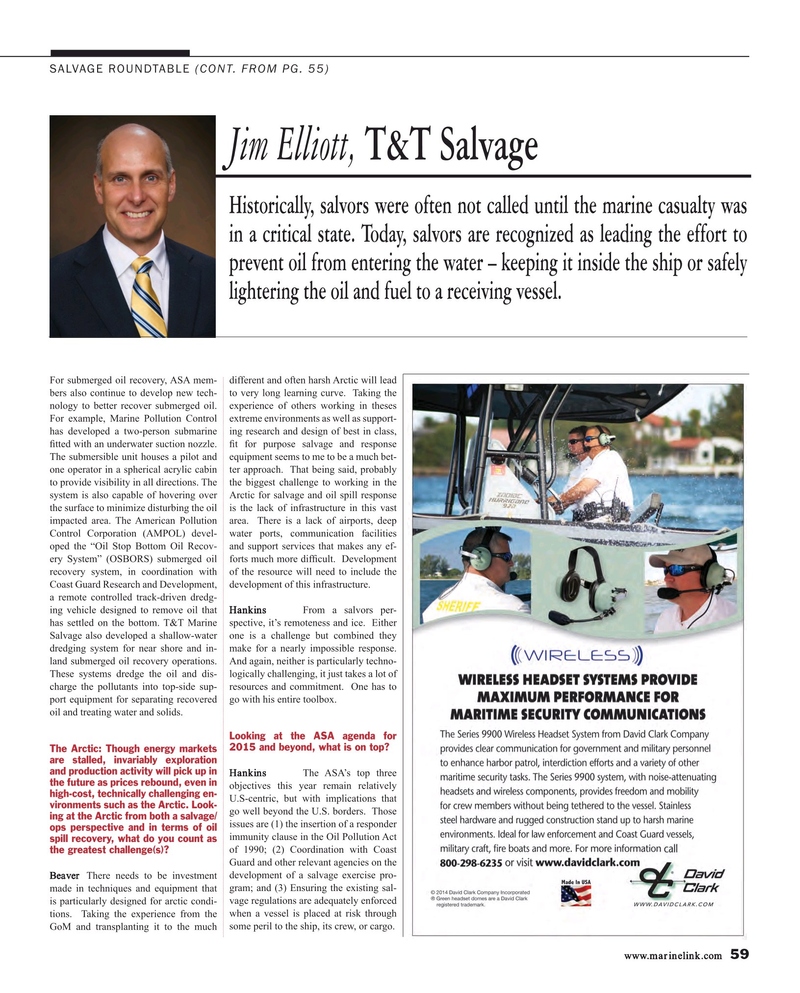
Page 59: of Maritime Reporter Magazine (March 2015)
U.S. Coast Guard Annual
Read this page in Pdf, Flash or Html5 edition of March 2015 Maritime Reporter Magazine
SALVAGE ROUNDTABLE (CONT. FROM PG. 55)
Jim Elliott, T&T Salvage
Historically, salvors were often not called until the marine casualty was in a critical state. Today, salvors are recognized as leading the effort to prevent oil from entering the water – keeping it inside the ship or safely lightering the oil and fuel to a receiving vessel.
For submerged oil recovery, ASA mem- different and often harsh Arctic will lead bers also continue to develop new tech- to very long learning curve. Taking the nology to better recover submerged oil. experience of others working in theses
For example, Marine Pollution Control extreme environments as well as support- has developed a two-person submarine ing research and design of best in class, ? tted with an underwater suction nozzle. ? t for purpose salvage and response
The submersible unit houses a pilot and equipment seems to me to be a much bet- one operator in a spherical acrylic cabin ter approach. That being said, probably to provide visibility in all directions. The the biggest challenge to working in the system is also capable of hovering over Arctic for salvage and oil spill response the surface to minimize disturbing the oil is the lack of infrastructure in this vast impacted area. The American Pollution area. There is a lack of airports, deep
Control Corporation (AMPOL) devel- water ports, communication facilities oped the “Oil Stop Bottom Oil Recov- and support services that makes any ef- ery System” (OSBORS) submerged oil forts much more dif? cult. Development recovery system, in coordination with of the resource will need to include the
Coast Guard Research and Development, development of this infrastructure.
a remote controlled track-driven dredg- ing vehicle designed to remove oil that Hankins From a salvors per- has settled on the bottom. T&T Marine spective, it’s remoteness and ice. Either
Salvage also developed a shallow-water one is a challenge but combined they dredging system for near shore and in- make for a nearly impossible response. land submerged oil recovery operations. And again, neither is particularly techno-
These systems dredge the oil and dis- logically challenging, it just takes a lot of charge the pollutants into top-side sup- resources and commitment. One has to port equipment for separating recovered go with his entire toolbox.
oil and treating water and solids.
Looking at the ASA agenda for
The Arctic: Though energy markets 2015 and beyond, what is on top?
are stalled, invariably exploration and production activity will pick up in
Hankins The ASA’s top three the future as prices rebound, even in objectives this year remain relatively high-cost, technically challenging en-
U.S-centric, but with implications that vironments such as the Arctic. Look- go well beyond the U.S. borders. Those ing at the Arctic from both a salvage/ issues are (1) the insertion of a responder ops perspective and in terms of oil immunity clause in the Oil Pollution Act spill recovery, what do you count as of 1990; (2) Coordination with Coast the greatest challenge(s)?
Guard and other relevant agencies on the
Beaver There needs to be investment development of a salvage exercise pro- made in techniques and equipment that gram; and (3) Ensuring the existing sal- is particularly designed for arctic condi- vage regulations are adequately enforced tions. Taking the experience from the when a vessel is placed at risk through
GoM and transplanting it to the much some peril to the ship, its crew, or cargo.
www.marinelink.com 59
MR #3 (58-65).indd 59 MR #3 (58-65).indd 59 3/3/2015 2:38:17 PM3/3/2015 2:38:17 PM

 58
58

 60
60
